Project News
2012-04-10
Study tour to Kon Tum organized
The Project for Sustainable Forest Management in the Northwest Watershed Area (SUSFORM-NOW) organized a study tour to Kon Tum Province from 27 to 31 March 2012. With the assistance from the Economic Division of Kon Tum City People's Committee, the tour participants visited a project on community livelihoods improvement and food safety in Dak Rowa Commune, Kon Tum City.
The study tour participants were totally 22 people, consisted of 16 members (one provincial, four district and city, two commune, and nine village level participants) selected by the Vietnamese counterpart agency and six staff of the project's livelihoods component.
During the study tour, the participants undertook discussion with the Economic Division of Kon Tum City People's Committee and commune-level Women's Union that were operating pig bank, interview with beneficiary farmers, and internal discussion among the tour participants. The major field visit sites included (1) pig bank, (2) contour cropping, (3) Bahnar textiles (textiles produced by the Bahnar people), and (4) media center.
(1) Pig bank operation
The participants exchanged opinions on pig bank operation including repayment to the pig bank, types of pigs, repayment rate and scope, management and operation, support from the project, and others.
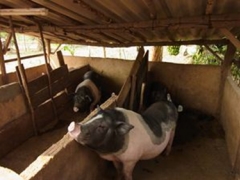 Visited Farm A: The household had completed necessary repayment, returning 100% of piglets from the first delivery and 40% from the second delivery. The household could keep all piglets afterward.
Visited Farm A: The household had completed necessary repayment, returning 100% of piglets from the first delivery and 40% from the second delivery. The household could keep all piglets afterward.
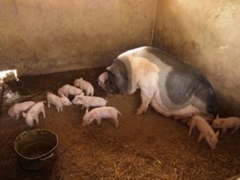 Visited Farm B: Due attention should be paid for the health condition of pigs rather than their number in repayment.
Visited Farm B: Due attention should be paid for the health condition of pigs rather than their number in repayment.
(2) Contour cropping
The project in Kon Tum Province has introduced a slope farming model that increases productivity through regeneration of soil fertility. In this model, the upper slopes are intensively reforested with native tree species, Litsea glutinosa, to prevent soil erosion while middle to lower slopes are planted with leguminous, green manure crops and Litsea glutinosa along contour lines. The project is also providing the extension service for the technique of planting annual crops such as cassava between these contour lines. The project is using Tephrosia candida and Cassia splendida as green manure crops.
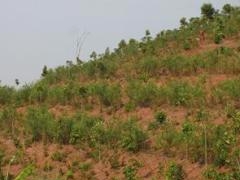 Non-Tephrosia green manure crops planted along contour liens with Litsea glutinosa and cassava planted in between.
Non-Tephrosia green manure crops planted along contour liens with Litsea glutinosa and cassava planted in between.
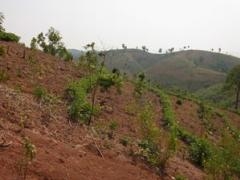 Tephrosia planted along contour line with Litsea glutinosa and cassava planted in between.
Tephrosia planted along contour line with Litsea glutinosa and cassava planted in between.
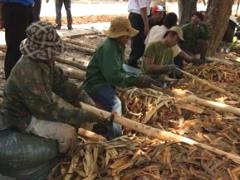 Barks of Litsea glutinosa are exported to China and India for incense making with its trunk sold as construction material (the picture taken at a processing factory in the city).
Barks of Litsea glutinosa are exported to China and India for incense making with its trunk sold as construction material (the picture taken at a processing factory in the city).
(3) Handicraft promotion with Bahnar textiles
Twelve women from two villages participate in textile and handicraft production.
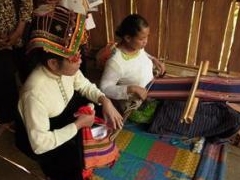 Textile demonstration.
Textile demonstration.
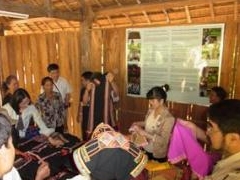 Sales of handicrafts to visitors.
Sales of handicrafts to visitors.
(4) Media center
The media center is located next to a clinic along the main road and equipped with computers, a projector, books, and digital material. There is a model farm of medicinal plants next to the center where the people visiting the clinic can learn the effects of these plants.
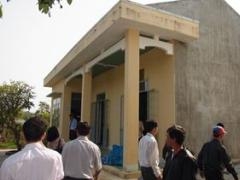 Media center.
Media center.
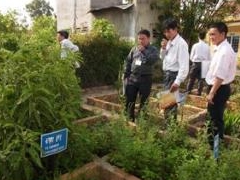 Model farm of medicinal plants.
Model farm of medicinal plants.
With the experience and lessons learned from the Kon Tum study tour, SUSFORM-NOW plans to implement the activities such as animal bank and contour cropping.
- About JICA
- News & Features
- Countries & Regions
- Our Work
- Thematic Issues
- Types of Assistance
- Partnerships with Other Development Partners
- Climate Change / Environmental and Social Considerations
- Evaluations
- Compliance and Anti-corruption
- Science and Technology Cooperation on Global Issues
- Research
- JICA Development Studies Program / JICA Chair
- Support for the Acceptance of Foreign HRs / Multicultural and Inclusive Community
- Publications
- Investor Relations
